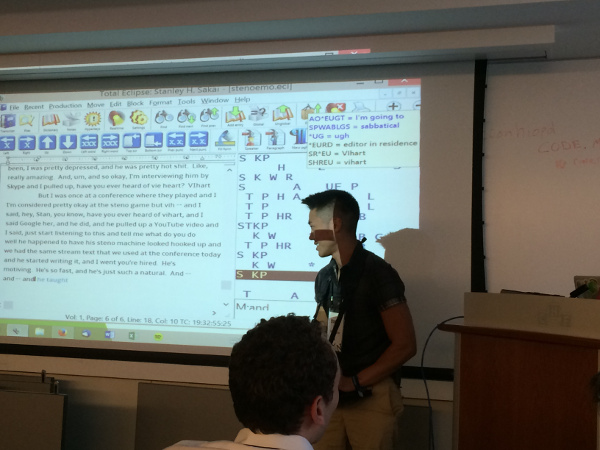Captioning a Multi-Track Conference - How SRCCON Did It
by Erika Owens

Stanley Sakai telling the SRCCON crowd about being a stenographer. (Photo: Chris A. Williams)
One of the nerdiest elements of our first SRCCON didn’t end up involving code or jokey references. As we were prepping for SRCCON last year, I caught a blog post related to !!Con: Your next conference should have real-time captioning. I had never heard of event captioning before. I found the blog post convincing, but we were less than two months away from SRCCON, could we pull off something like this?
By reaching out to the fabulous Mirabai Knight who captioned !!con and reprogramming some of our event budget, we were able to make captioning at SRCCON happen.
Why Did We Prioritize Having Transcription?
- Accessibility is the main and obvious reason. No SRCCON attendees had reached out requesting captioning services, but we knew there were likely to be people in a lot of situations that could benefit from captioning. Deaf and hard of hearing folks, people for whom English is a second langauge, and people who need to pop out of a session for a few minutes, such as mothers who have to pump breast milk are all groups who benefit from being able to read a conversation happening during a session.
- Virtual connection. Additionally, people unable to attend the event could follow along online. This was especially important for the first year of SRCCON as tickets sold out much more quickly than we anticipated.
- Immediate record. Instead of waiting for notes or links to flow in weeks after the event, the session itself was creating a record that could be referred back to.
How’d We Do It?
- Amazing referral. Mirabai was unavailable for our event, but she put us in touch with Norma Miller who was able to convene a team of three stenographers for our event.
- Multiple sessions. In talking with Norma, we realized that one of the first challenges would be the fact that unlike !!con, SRCCON was planned to have five concurrent sessions. Norma was able to tap her network and find two other stenographers to join us at the event, and she helped us talk through what types of sessions would work best for transcription. Our sessions were designed to be participatory and interactive, with some hands-on trainings as well. We selected the sessions that seemed like they would be easiest for a stenographer to follow. In each session window, three of the five sessions were transcribed.
- Logistics prep. Norma’s team came with all of their own gear and fancy keyboards. We worked with the venue to make sure that there were comfortable chairs for the stenographers in each room as well as an accessible ethernet cable so that they could keep on typing, even if the wifi wavered. We also had name tags ready for Norma and team, and introduced them and what they’d be doing in the opening plenary.
- Online live stream. Norma’s team used StreamText.net to record their transcripts and share them in real-time online. We linked it up on the SRCCON.org site. At other events, Norma would also display the transcript in real time on a screen, but we decided that for our audience, people being able to follow along individually on their devices was best for our audience.
What’d We Learn for Next Time?
- Nerd. Party. The most unexpected part of having live transcription at our event was how much everyone nerded out about it! The stenographers became the stars of SRCCON. People were fascinated by the technology the stenographers used and their blazing typing speed. Norma’s colleague Stanley Sakai gave a short talk about transcription and one of the closing events of SRCCON became a face off: debate speed speaking champ v. Norma and her steno machine.
- Involve transcription in more aspects of our planning. Since we found out about transcription rather late, we didn’t have a specific sponsorship type for supporting transcription, but other events have found transcription sponsorship to be a popular offering, so we expect to have that this year. In addition, we linked to the live streams of the sessions on our site, but we could do more to weave the streams and the transcripts they created into our site and program.
- Additional accessibility considerations. We put a lot of intentionality into planning the SRCCON program and structure, but we could do more to make sure we’re anticipating our attendees’ needs and giving plenty of opportunities to inform us of adjustmets we could make. I read a fantastic zine, Deafula #7: Accessible Spaces, with a lot of great suggestions and insights to what events can do to be more accessible.
We’re really looking forward to having live transcription again at SRCCON this year. I’m also excited to hear it being talked about for other conferences and I am always available to chat more about our experience. Accessibility: it’s the right thing to do, plus it can be super nerdy fun.
The latest from the OpenNews team
Looking back at 2023: We spent this year creating opportunity
How we connected at SRCCON 2023, and what we're carrying into next year
Read all our news in our OpenNews blog

